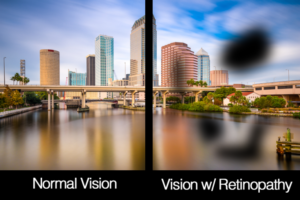Diabetic Eye Disease
Understanding Diabetic Eye Disease
Diabetic eye disease encompasses a range of conditions affecting the eyes of individuals with diabetes, with diabetic retinopathy being the most common. It’s crucial to recognize the potential severity of these conditions and the importance of early detection and treatment to preserve vision and prevent vision loss.
Diabetic Retinopathy: A Leading Cause of Vision Loss
Diabetic retinopathy stands as the primary cause of vision loss among working-age Americans. This condition results from damage to the blood vessels in the retina, the light-sensitive tissue at the back of the eye. The risk of blindness in diabetic individuals is significantly elevated, with a staggering 25 times higher risk compared to non-diabetic individuals. However, it’s essential to note that much of this vision loss is preventable through timely intervention and proper management.
Early Detection Saves Sight
Annual dilated eye exams are strongly recommended for all individuals with diabetes to screen for any signs of retinal damage. These comprehensive exams allow for the early detection of diabetic retinopathy and other diabetic eye conditions, enabling prompt treatment to preserve vision and prevent further complications.
Diagnosis and Assessment
Diagnosing diabetic retinopathy involves a thorough examination of the retina by a qualified retina specialist. In the early stages, characteristic signs such as small aneurysms, bleeding, or lipid deposits may be observed. As the condition progresses, more severe manifestations such as macular edema (swelling in the central part of the retina) and neovascularization (abnormal blood vessel growth) may develop. These advanced stages can lead to significant vision impairment and even blindness if left untreated.
Treatment Options
Early intervention is key in managing diabetic retinopathy and preventing vision loss. Laser treatment, such as focal laser therapy, is commonly employed to address macular edema and control the progression of the disease. In cases of neovascularization, pan-retinal laser treatment may be necessary to prevent further complications.
In addition to laser therapy, injections of steroids or other medications may be administered to individuals who do not respond adequately to laser treatment alone. These injections can help reduce inflammation and swelling in the retina, thereby preserving vision.
In severe cases where diabetic retinopathy has led to complications such as retinal detachment, surgical intervention may be required to restore and preserve vision.
Trust Your Vision to Newsom Eye
At Newsom Eye, our dedicated team of retina specialists in Tampa and Sebring is committed to providing comprehensive care for individuals with diabetic eye disease. From early detection through advanced treatment options, we are here to support you on your journey to optimal eye health and vision preservation.
Don’t let diabetic eye disease threaten your vision. Schedule your comprehensive eye exam with Newsom Eye today and take proactive steps towards protecting your vision for years to come.


